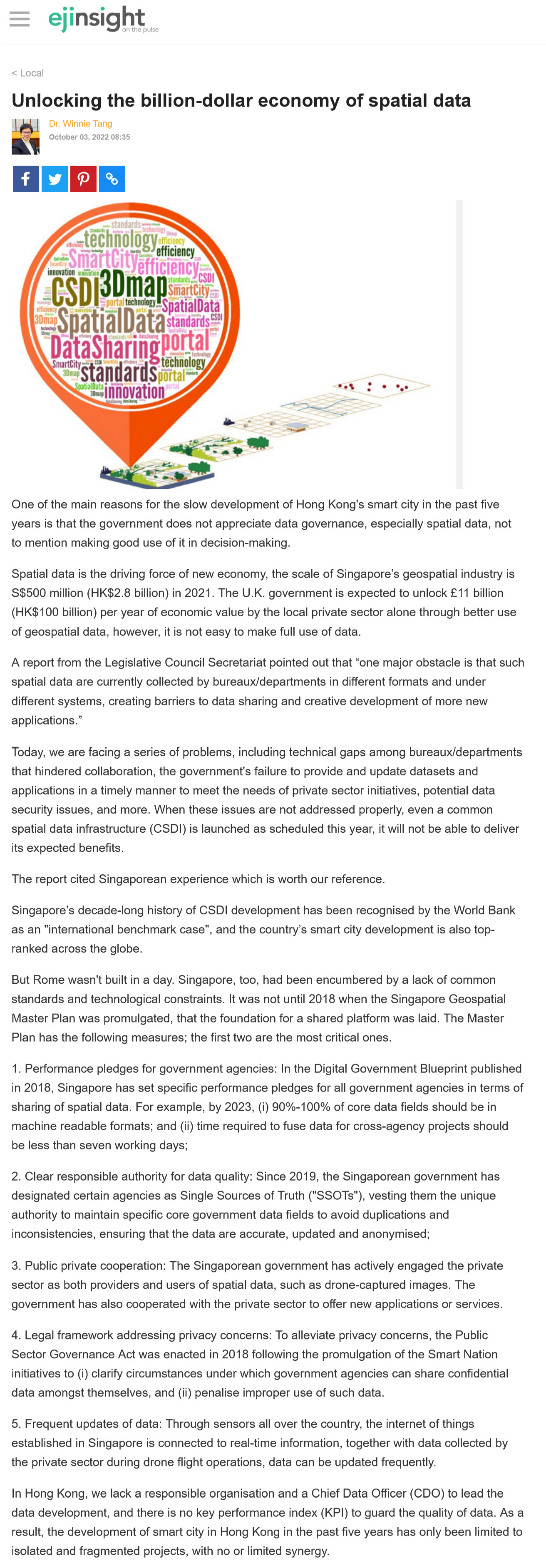網上版請按此

Unlocking the billion-dollar economy of spatial data
One of the main reasons for the slow development of Hong Kong's smart city in the past five years is that the government does not appreciate data governance, especially spatial data, not to mention making good use of it in decision-making.
Spatial data is the driving force of new economy, the scale of Singapore's geospatial industry is S$500 million (HK$2.8 billion) in 2021. The U.K. government is expected to unlock £11 billion (HK$100 billion) per year of economic value by the local private sector alone through better use of geospatial data, however, it is not easy to make full use of data.
A report from the Legislative Council Secretariat pointed out that "one major obstacle is that such spatial data are currently collected by bureaux/departments in different formats and under different systems, creating barriers to data sharing and creative development of more new applications."
Today, we are facing a series of problems, including technical gaps among bureaux/departments that hindered collaboration, the government's failure to provide and update datasets and applications in a timely manner to meet the needs of private sector initiatives, potential data security issues, and more. When these issues are not addressed properly, even a common spatial data infrastructure (CSDI) is launched as scheduled this year, it will not be able to deliver its expected benefits.
The report cited Singaporean experience which is worth our reference.
Singapore's decade-long history of CSDI development has been recognised by the World Bank as an "international benchmark case", and the country's smart city development is also top-ranked across the globe.
But Rome wasn't built in a day. Singapore, too, had been encumbered by a lack of common standards and technological constraints. It was not until 2018 when the Singapore Geospatial Master Plan was promulgated, that the foundation for a shared platform was laid. The Master Plan has the following measures; the first two are the most critical ones.
1. Performance pledges for government agencies: In the Digital Government Blueprint published in 2018, Singapore has set specific performance pledges for all government agencies in terms of sharing of spatial data. For example, by 2023, (i) 90%-100% of core data fields should be in machine readable formats; and (ii) time required to fuse data for cross-agency projects should be less than seven working days;
2. Clear responsible authority for data quality: Since 2019, the Singaporean government has designated certain agencies as Single Sources of Truth ("SSOTs"), vesting them the unique authority to maintain specific core government data fields to avoid duplications and inconsistencies, ensuring that the data are accurate, updated and anonymised;
3. Public private cooperation: The Singaporean government has actively engaged the private sector as both providers and users of spatial data, such as drone-captured images. The government has also cooperated with the private sector to offer new applications or services.
4. Legal framework addressing privacy concerns: To alleviate privacy concerns, the Public Sector Governance Act was enacted in 2018 following the promulgation of the Smart Nation initiatives to (i) clarify circumstances under which government agencies can share confidential data amongst themselves, and (ii) penalise improper use of such data.
5. Frequent updates of data: Through sensors all over the country, the internet of things established in Singapore is connected to real-time information, together with data collected by the private sector during drone flight operations, data can be updated frequently.
In Hong Kong, we lack a responsible organisation and a Chief Data Officer (CDO) to lead the data development, and there is no key performance index (KPI) to guard the quality of data. As a result, the development of smart city in Hong Kong in the past five years has only been limited to isolated and fragmented projects, with no or limited synergy.
Dr. Winnie Tang
Adjunct Professor, Department of Computer Science, Faculty of Engineering; Department of Geography, Faculty of Social Sciences; and Faculty of Architecture, The University of Hong Kong